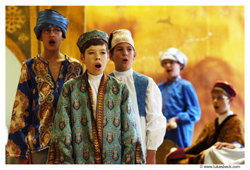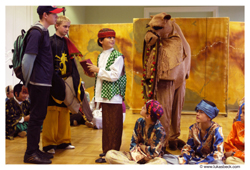Modern Day Minstrels - The Vienna Boys’ Choir
On their 90th tour of the United States, Ambassador Eva Nowotny welcomed the Vienna Choir Boys at a special appearance at the Austrian Embassy in Washington, D.C. on October 26, 2004 before an appreciative audience of some four hundred guests attending Austria's National Day (see front cover). The choir presented four songs including selections from Robert Schuman and Johann Strauss, along with the national anthems of Austria, the European Union and the United States.
The Silk Road
The Boys' Choir's tour throughout the United States during the months of October to December, 2004 included a colorful new children's opera featuring original music from the Silk Road. Initially premiering at Vienna's Museum of Social Anthropology in the fall of 2003, the opera tells the story of a boy named Christian who travels along the old trade route called the Silk Road, accompanied by a two thousand year-old Chinese ghost and a talking camel. The unlikely trio climbs mountains and crosses deserts. They meet merchants, traders, beggars, nomads, sheikhs, snake charmers, pickpockets - and in the end, they even save a life. The journey is complete with rain dance, Oriental crowds and a sandstorm. The music is stirring, exuding a sense of magic and evoking laughs and animated responses.
The choir's Silk Road journey began with extensive background research by the two authors of the piece, orientalist Tina Breckwoldt, and stage director Rebecca Scheiner, of the Vienna State Opera. After accumulating a wealth of material from Central Asia, they devised the story of the threesome around the contents of eight different songs, all sung in the original languages. "We did a lot of reading, saw documentaries, and went to exhibitions. To arrange the songs, one had to work from field recordings; there was no sheet music. We do not claim to play 'authentic' world music, rather we create something from the original sources that suits the boys' voices and is our own. We want to be faithful to the source by treating it with respect." The songs, sung in Farsi, Mandarin, Tajik, Turkish, Urdu, Uzbek and Uyghur, include a Turkish qawwali, a Persian ghazal and field hollers from Tajikistan. The boys themselves accompany the songs on ethnic drums. The busy crowd scenes bring the mysterious Orient to life. On stage is a bazaar, an Oriental court of law, a rain dance inspired by Pashtu dances and even a sand storm.
Ms. Scheiner sees the Silk Road project as a plea for more understanding between cultures. "The three travellers are guests wherever they go. They are confronted with differences; they watch and observe; they do not impose. 
Performance of the Silk Road on Tour (2004)
History of the Vienna Boys' Choir
In 1498 Emperor Maximilian I gave specific instructions for six boys to be among his musicians which formed the Vienna Hofmusikkapelle, the official founding of the Vienna Boys'
Choir. Until 1918 the choir sang exclusively for the imperial court, at mass, at private concerts and functions and on state occasions.
In 1918 after the decline of the Habsburg Empire, the Austrian government took over the court opera but not the choir of boys. The choir owes its survival to Josef Schnitt who made it a private institution, replacing the imperial uniform with the sailor suit, the height of boys' fashion. Funding was not enough to pay for the children's upkeep, so in 1926 the choir began giving concerts outside of the traditional places. The impact was amazing: Within a year, the choir was performing in the early 1930s as far away as the United States, Australia and South America.
Present
Currently there are about 100 singers between the ages of ten and fourteen, divided into four choirs. The four choirs give some 300 performances every year. Each choir spends nine to eleven weeks of the school year on tour visiting Europe, Asia, Australia and the Americas. At home the choir provides the music for the Sunday Mass in Vienna's Imperial Chapel, as they have done since 1498.
Repertoire
The choir's repertoire includes everything from medieval to contemporary and experimental music. The choir has a long tradition of commissioning new works, such as The Golden Vanity written by Benjamin Britten. Sometimes they perform major choral and symphonic works with other orchestras or men's choirs or provide soloists, such as for Bernstein's Chichester Psalms, or Mahler's Das klagende Lied. Recent guest conductors include Pierre Boulez, Nikolaus Harnoncourt, Zubin Mehta, Riccardo Muti, and Seiji Ozawa, among others.
The Choir's School
The Vienna Boys' Choir has its own school. They study and rehearse in the Palais Augarten, a baroque palace and former imperial hunting lodge in Vienna. Beginning with kindergarten, boys and girls are provided with a complete musical and general education through the elementary grades. At age ten the most talented boys are selected to join the choir and enter the choir's grammar school. All boys are assigned to one of the touring choirs.
The students are also encouraged to create their own projects; a number of them write, act and direct short sketches or films. Many of the alumni go on to become professional musicians, conductors, singers or instrumentalists in Vienna and throughout the world, retaining a lifelong commitment to the Arts. For more information, see: http://www.wsk.at
Scene with the famous "Talking Camel"
